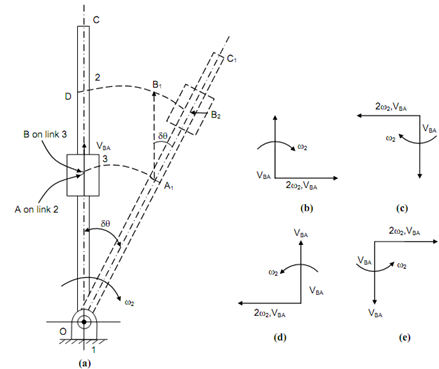Determining Coriolis Component of Acceleration:
In rigid body rotation, distance of any point from the axis of rotation remains fixed. If a link rotates around a fixed centre and, at the similar time, a point moves over it along the link, the absolute acceleration of the point is illustrated by the vector sum of
(1) The absolute acceleration of the coincident point relative to that the point, under consideration, is moving;
(2) Acceleration of the point associated to the coincident point; and
(3) Coriolis' component of acceleration.
Figure illustrates a link 2 rotating at constant angular speed say ω2, this move from position OC to OC1. Throughout this interval of time, the slider link 3 moves outwards from position B to B2 along constant velocity VBA (A is point on link 2 shich coincides along B that is on link 3). The motion of the slider 3 from B to B2 might be considered in the three stages which are following:
(a) B to A1 because of rotation of link 2,
(b) A1 to B1 because of outward velocity VBA,
(c) B1 to B2 because of acceleration perpendicular to the link which is the Coriolis' component of acceleration.
Arc B1 B2 = Arc DB2 - Arc DB1
= Arc DB2 - Arc AA1
Also
Arc B1 B2 = A1 B1 δ θ = VBA δ t ω2 δ t
= VBA ω2 (δt) 2
The tangential component of the velocity is perpendicular to the link is say Vt and this is given by following
Vt = r ω
In this case ω has been supposed constant and slider moves having constant velocity. Thus, tangential velocity of point B on the slider 3 shall result in uniform increase in tangential velocity due to uniform increase in value of r in the above equation.

To result in consistent increase in value of Vt, there need to exist constant acceleration perpendicular to link 2.
Hence,

here a is the acceleration.
∴ 1/2 a (δt )2 = VBA ω2 (δt)2
a = 2 VBA ω2
It is Coriolis' component of acceleration and will be mentioned by .
.
Hence ,
 = 2 ω2 VBA
= 2 ω2 VBA
The directional relationship of VBA and 2 ω2 VBA is illustrated in Figures (b), (c), (d) and (e). If slider moves to centre of rotation o, its velocity may be transmitted to other side so that this is directed outwards.
The direction of Coriolis' component of acceleration is illustrated by the direction of the relative velocity vector for the two coincident points rotated by 90o in the direction of the angular velocity of the rotation of the link.
If the angular velocity ω2 & the velocity VBA are differ, they will not influenced the expression of the Coriolis' component of acceleration however their instant values will be utilized in determining the magnitude and this value shall be applicable at that instant.